

While we flew in and out of Tokyo-Narita airport on our around the world air ticket, our first stop in Japan was Osaka. We stayed for about a week, ate as much ramen as we could, walked a ton, and really enjoyed it. It may just be because it is such a contrast to our experience in India, but we were really thankful for how walkable the city is and how willing everyone was to try to help us.
We decided to stay in Osaka, rather than the more-popular-among-tourists Kyoto because throughout our trip we’ve enjoyed good food and residential neighborhoods a lot more than temples and tourist hotspots. Plus, with a Japan Rail Pass in-hand, Kyoto was just 15 minutes on the Shinkansen “bullet train” away.
Osaka and the surrounding area was one of the most livable destinations we’ve traveled to so far. The public transportation is amazing, most everyone seems to bicycle around for shorter trips, and everything is clean and safe. It honestly left both of us wishing we could easily learn Japanese and spend more time here.
Day 1: We landed in Tokyo early in the morning after an overnight flight, made our way through one of the most efficient immigration/customs systems we’ve had the joy of encountering on our trip, and immediately found the JR East Ticket Office so that we could trade our rail pass vouchers for actual rail passes (more on that, and trains here in general, to come in a separate post). Exactly an hour after we walked off our plane we were standing on the airport’s train platform waiting for our Narita Express train into downtown Tokyo.
Once we arrived at Tokyo Station we got our first taste of Tokyo rush-hour crowds, but managed to buy contactless reloadable metro cards that work not only in Tokyo but pretty much all over Japan. We also stopped at Ekibenya Matsuri, a large shop inside the Shinkansen selling countless varieties of ekiben, which is the name for any bento box sold at a train station or onboard a train. While they have pictures of what is in each box, no descriptions are in English, so we made some educated guesses and grabbed a couple boxes to enjoy on our 3-hour train to Osaka.
Once we arrived at Shin-Osaka Station, we got to use those metro cards for the first time to travel about 15 minutes to the Dotonbori neighborhood, where our Airbnb was. We met the host, got out key, and immediately took a brief rest since we were pretty exhausted from two consecutive nights of travel (first a train to Delhi, then our flight to Tokyo). Our flight landed outside Tokyo just before 7am and we got to our Airbnb in Osaka by 2:30pm, even with generous connection times on our trains to make it less stressful–pretty good!
Before we went to sleep, we took a walk to explore the neighborhood. The nearby market was already closing up for the day, but we walked through the heart of touristy Dotonbori and had our first successful interaction with a Japanese vending machine: we got ramen at Kinryu Ramen, where like a lot of other places you make you selection at a vending machine, pay, and then simply hand your ticket to the cook/server. It’s an amazingly efficient system, especially since most vending machines can handle giving change in both bills and coins, so you don’t have to worry about having exact change. While Kinryu is much less popular than some of the surrounding stores with block-long lines, it was good and about half the price of other nearby meals.
With food in our stomach and facing exhaustion we stopped at a cheap grocery store our Airbnb host had recommended, stocked up on some soup and fruit for breakfast, and were asleep by 9pm!
Day 2: Our first full day in Osaka was beautiful–blue skies, mid-seventies, and a light breeze. After so many sweaty days in India it was blissful and we ended up walking almost 13 miles while exploring Dotonbori, the Osaka Castle area, and the O River waterfront.
Osaka Castle is one of the major tourist destinations in Osaka, and we really enjoyed wandering through its grounds and enjoying the scenery. Without realizing it, we had ended up in the city for its peak cherry blossom bloom, so many locals and domestic tourists were joining us around the cherry trees. There was also a lot of Hanami, or picnicking under the cherry blossom trees, all around us, with plenty of well prepared groups with nice tarps and fold-out tables to lay our their platters of sushi.
Just north of the Osaka Castle area is the O River, and we walked both shores for what seemed like a long time but ended up being less than half of the 4+ miles of long waterfront park. With such great weather it was wonderful just to be outside, and we were really thankful for how easy it was to just walk around, people-watch, and enjoy the scene.
For dinner, we went to 福太郎, a famous Okonomiyaki restaurant in Dotonbori that seemed most popular with locals and domestic tourists (probably somewhat due to not having an English name/sign outside). Okonomiyaki is a savory Japanese egg pancake filled with whatever you choose to have put in it, but most commonly its filled with vegetables and slices of pork or seafood. It is grilled right in front of you and left on the hot griddle to stay warm as you cut it apart and eat it. We had two very good ones, but didn’t feel like they were as satisfying as a good bowl of ramen.
Day 3: Since we had headed north from our Airbnb the day before, on our third day we went south. Our main destination was Tsutenkaku, a compact neighborhood full of restaurants and shops and right beside a nice green space. Here, we took an opportunity to try Takoyaki, ball-shaped hot dough stuffed with octopus. They were a lot runnier on the inside than I expected, and we’re not sure if that’s always true or if we just got an undercooked serving.
After filling up, we walked around Tenshiba Park, which was packed to the brim with picnicking families and locals strolling around. While we were really enjoying the nice weather, it seemed like everyone was treating it almost like the first nice day of spring when everyone runs outside after the long winter. We then crossed the grounds of the Osaka City Museum of Fine Arts and wandered around another adjacent park, 和気橋. With a nice large pond full of turtles snapping at floating cherry blossoms and a great bridge to watch from, it was a very relaxing stop.
We finished our long walk back to our Airbnb, but not before stopping at a Melon Bread Ice Cream stall in central Dotonbori, where we treated ourselves to a helping of hot sweet bread, sliced open and stuffed with freshly-scooped ice cream. As you can expect, it’s hard to mess up those flavors and we loved our treats. Not sure we completely earned them since we only walked 10 miles on the day, one of our lower totals for our time in the Osaka area…
For dinner, we ate at the nearby branch of Ichiran Ramen, a nationwide chain that specializes in letting you customize every part of your ramen order: how hard/soft you want the noodles to be, how rich the broth should be, how spicy, etc. After eating at so many family-run places throughout Southeast Asia we’re having to adjust back to not being upset when we decide to eat somewhere more corporate, and Ichiran was well worth the stop.
Day 4: The next day was a big one, both for walking (16 miles!) and for train rides (11 of them!), as we made a trip to Kyoto and back. One big plus of having bought the rail passes is that for their validity we can take as many eligible trains as we want, which we took full advantage of. While most people going from Osaka to Kyoto would likely take a 45-60 minute regional train that is fairly cheap, we could take the 15-minute bullet train (nonstop) for free.
We set out early in the morning and after a metro, bullet train, and regional train arrived at Inari in southern Kyoto just over an hour after we had left our Airbnb in Osaka. (If you can’t tell, I’m continually amazed by how good and reliable public transit is in Japan.) Inari is the Shinto god of rice and Fushimi Inari is the most important of several thousands of shrines dedicated to Inari. We took a short look around the shrine near the entrance and then made the two hour loop up to the summit of the hill, where another shrine is located. The torii (orange gates) lining the paths all the way around make it a pretty unique walk to take, and there are great views of Kyoto along the way. There are also statues of foxes all around the gates and shrines because they are believed to be the messengers for Inari. Some of them look like they are guard foxes while others were more of the cute companion variety. One even had a hand-knitted hat to keep it warm.
After finishing our 4-mile steep walk, we got back on the subway and headed to Nishiki Market, a popular covered pedestrian street full of small restaurants, food stalls, and shops. There was more variety in the prepared food offerings than we’d seen at any other Japanese street market, but it was definitely geared toward tourists with more English translations than usual and noticeably higher prices. We did sample some sembei or rice crackers at Mochiyaki Senbei Terakoya, and like the softer type that we got with a variety of toppings over the crunchy more traditional version.
Since we hadn’t found a meal we wanted to have, we decided to walk another 2.5 miles past Niko Castle and to a running (conveyor belt) sushi place that we had found good reviews of. Unfortunately when we got there it appeared there was a 90-minute wait to sit down, though we were unable to confirm that since there were no English signs and no one who spoke any English was around. A bit dispirited, we hopped back on the subway and made the quick jaunt down to Tofukuji, where we stepped out of the station to find Daikoku Ramen, a cheap place full of locals enjoying very rich bowls of pork soup. While I love good pork, this broth may have been too rich even for me, and Amy definitely struggled a bit to finish it even though each spoonful tasted so good.
Amy had pre-booked a spot for a traditional tea ceremony at Ju An as a birthday present from one of her friends back home. I wasn’t interested in attending so left her with three couples to learn about the tools and practices around serving matcha tea (finely ground young green tea leaves) during tea ceremonies.
While she was learning about tea, I walked a couple blocks to explore Higashi Honganji, a large buddhist temple complex that was last rebuilt in 1895 after being burned down multiple times in the past 500 years. The scale of the buildings is really impressive, as is the dedication it took to transport the huge pieces of timber down from far-away mountaintops on crude wooden sleds.
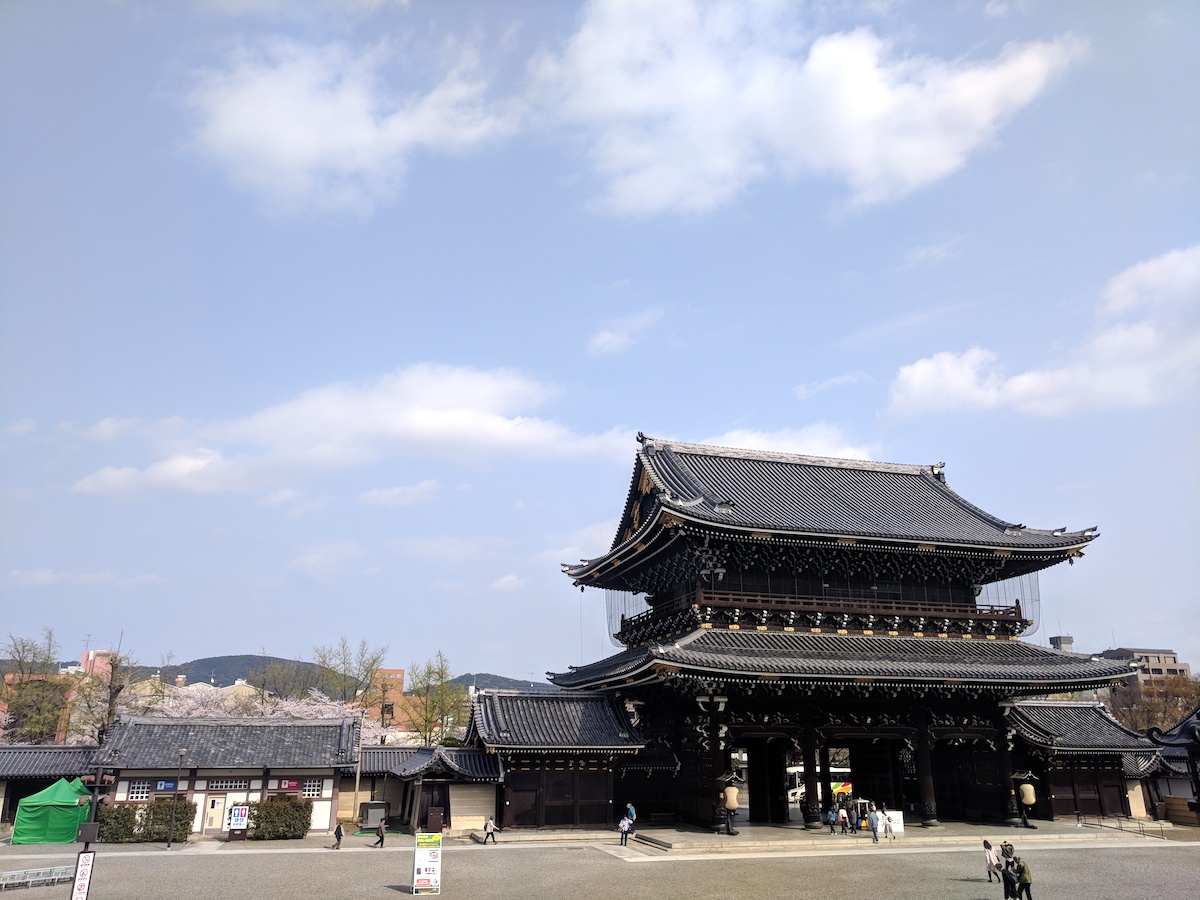
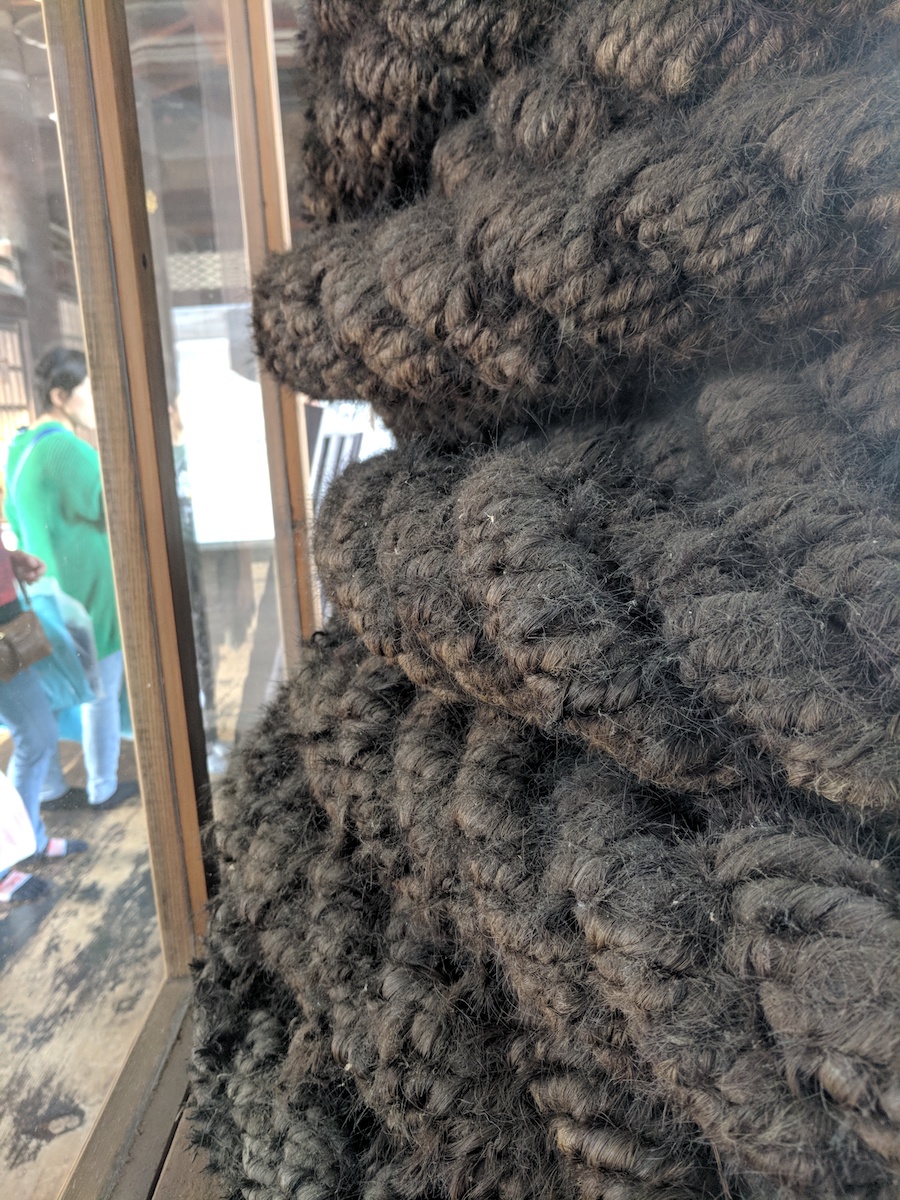
Left: One of the entry gates at Higashi Honganji–the temple buildings were too large to fit into one frame. Right: A thick rope over a hundred feet long made entirely from human hair around 1900, used to help transport timber.
After joining back up, we took the subway to Gion-Shijo, at one end of a popular shopping street bordered by a large public park and an area that has been historically preserved. Our favorite part of our time in the area was probably exploring Maruyama Park, which again was full of Japanese picnicking under cherry trees and enjoying the lovely spring weather. As it started to get dark, we ventured through Gionmachi Minamigawa, a neighborhood that has kept much more of its traditional character than most. We were lucky enough to happen to see a still-practicing geisha emerge from her home to head to an engagement, which was very cool though we were then horrified as other tourists began to literally sprinting after her with their selfie sticks ahead of them to try to get a photo with her as she walked. Her composure was impressive as she ignored them and completed her 3-minute walk without uttering a word as she gracefully dodged the oncoming tourist in her very high shoes, but it made us want to scream at the other tourists.
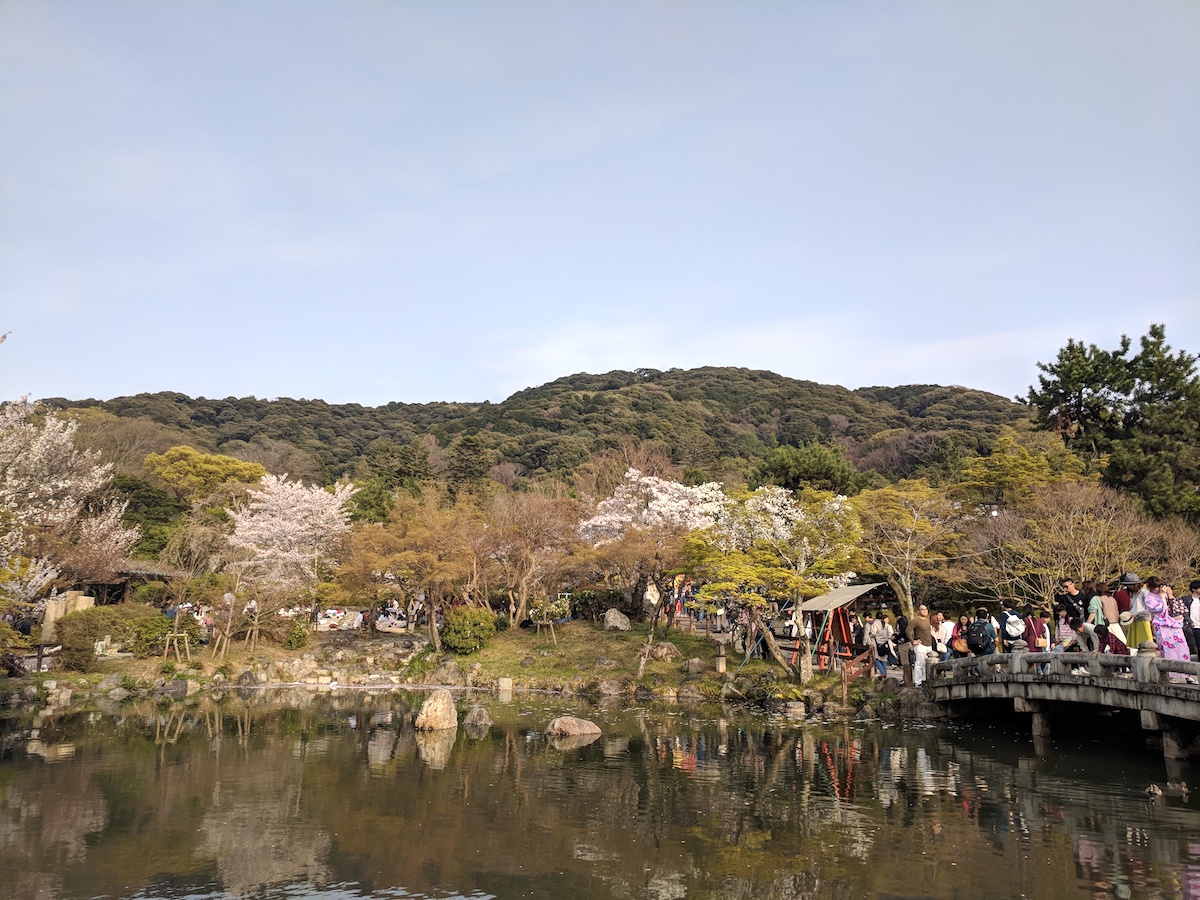
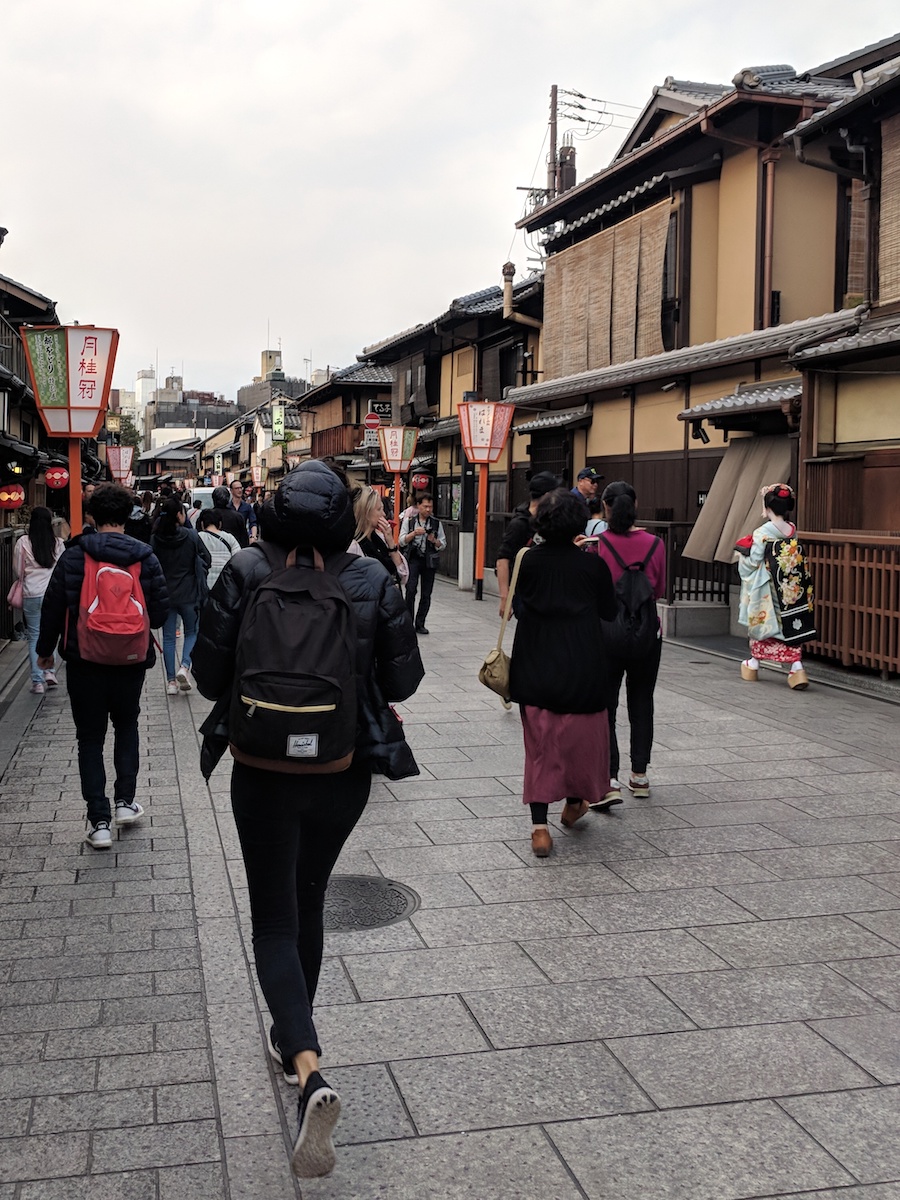
Left: Maruyama Park. Right: Gionmachi Minamigawa, with a practicing geisha walking at the far right (click to enlarge; check out those shoes!).
We then headed back to Osaka, grabbing bento boxes on the way back to our Airbnb and resting our tired feet for the rest of the night.
Day 5: On Monday, we planned to take it a bit easier since we had walked so much every day in Osaka after not getting nearly as much exercise in India. We were sore! I lasted until about lunchtime before getting antsy and getting Amy to agree to get out of the Airbnb and go explore some more.
We started off with lunch at Kushikatsu Daruma Nambahonten, a restaurant specializing the Osaka staple of individually-served fried skewers. We got a sampler platter to try a bunch of different things and ended up enjoying the chicken skin and fish sausage skewers a lot more than we expected. While we enjoyed it, we left feeling like it should be used as a snack between meals instead of a meal in itself, as all that fried batter left our mouths feeling a little filmy without the meal being all that filling.
We set off on another long walk and stumbled across a strip of dessert restaurants in northern Dotonbori. While others on the sidewalk were enjoying foot-high soft serve cones and cotton candy the size of a beach ball, we opted for another melon bread with ice cream, this time served even hotter out of the oven. Definitely not something we should learn to make ourselves!
In the afternoon, we met up with a friend of Amy’s from DC who happened to be on vacation in Osaka with her husband and went to Saké Shimada, an indescript liquor store in a quiet neighborhood away from all the tourists. However, we had read about their small basement tasting room where you can try different sakés at a low price. We spent about an hour, and ended up each having generous tastes of four very-different sakés. Our favorite was an orange-label bottle that tasted distinctly of chocolate. All four were much more drinkable than any saké I’ve ever had before–actually pleasant–and were served either cold or room temperature.
For dinner, we had another helping of okonomiyaki, this time at Chibo. While they usually have a line going down the block, we got their on the early side and only had to wait a few minutes. While the okonomiyaki was definitely good, it solidified our view that its just not our favorite thing.
Day 6: Since we had taken it a bit slower the day before, we planned another quick day trip for our final full day in the Osaka area. This time, we took the Shinkansen 15 minutes in the other direction, arriving at Shin-Kobe quickly and easily.
Unfortunately that’s where the quick and easy ended. My plan was to have us visit the Kobe Herb Gardens, a complex on the mountaintop beside the train station. We wanted to hike up instead of taking the cable car, both because we enjoy hikes and because it was a pretty overpriced cable car. The only step I missed in planning was figuring out where the trailhead was, since it seemed to be adjacent to the train station itself.
We went outside but couldn’t find a way over to the mountain-side of the station, so we decided to loop around to the cable car base station, figuring maybe the trail also started from there. We did find one trail, and took it, but after 15 minutes of climbing it started to loop back down and toward downtown, so we turned around, went back to the cablecar station, and asked for directions. Of course, the trail does start from the train station, you just have to go to the basement parking garage to find the exit door.
After getting back to the station we headed up the trail, a bit surprised by how steep it was immediately (stairs on stairs) but enjoying the picturesque views as we made switchbacks up under the running cable cars. Unfortunately after another 20 minutes of hiking it became clear that this trail, too, looped back toward downtown and was not the way to the mountain top. After backtracking to the train station once again we realized the trailhead was actually through a small residential area beside that steep trail that we had initially ignored. We also noticed all the signs pointing the right way… For someone who doesn’t normally have any challenges navigating, it was a pretty depressing display and put us both over an hour later than hoped and already a bit tired by the time we started up the right trail!
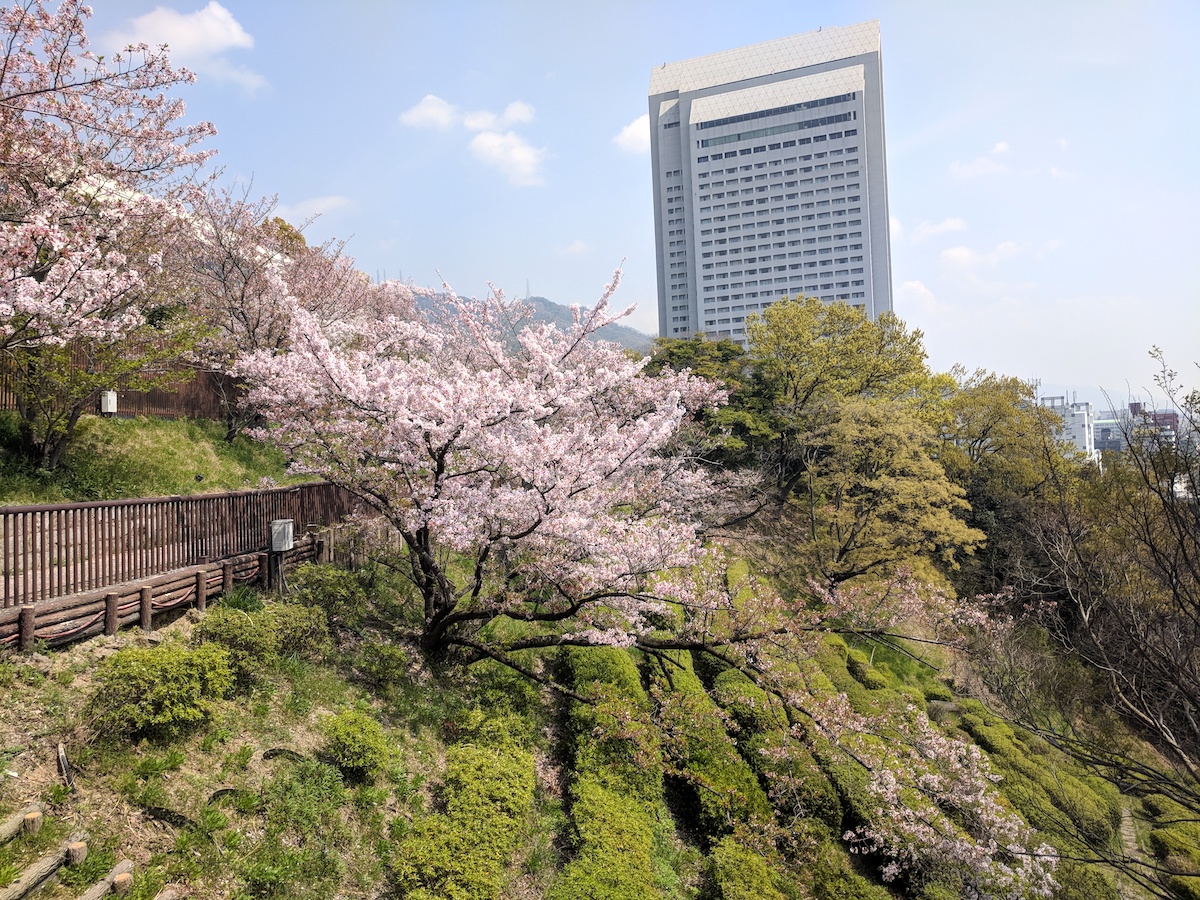
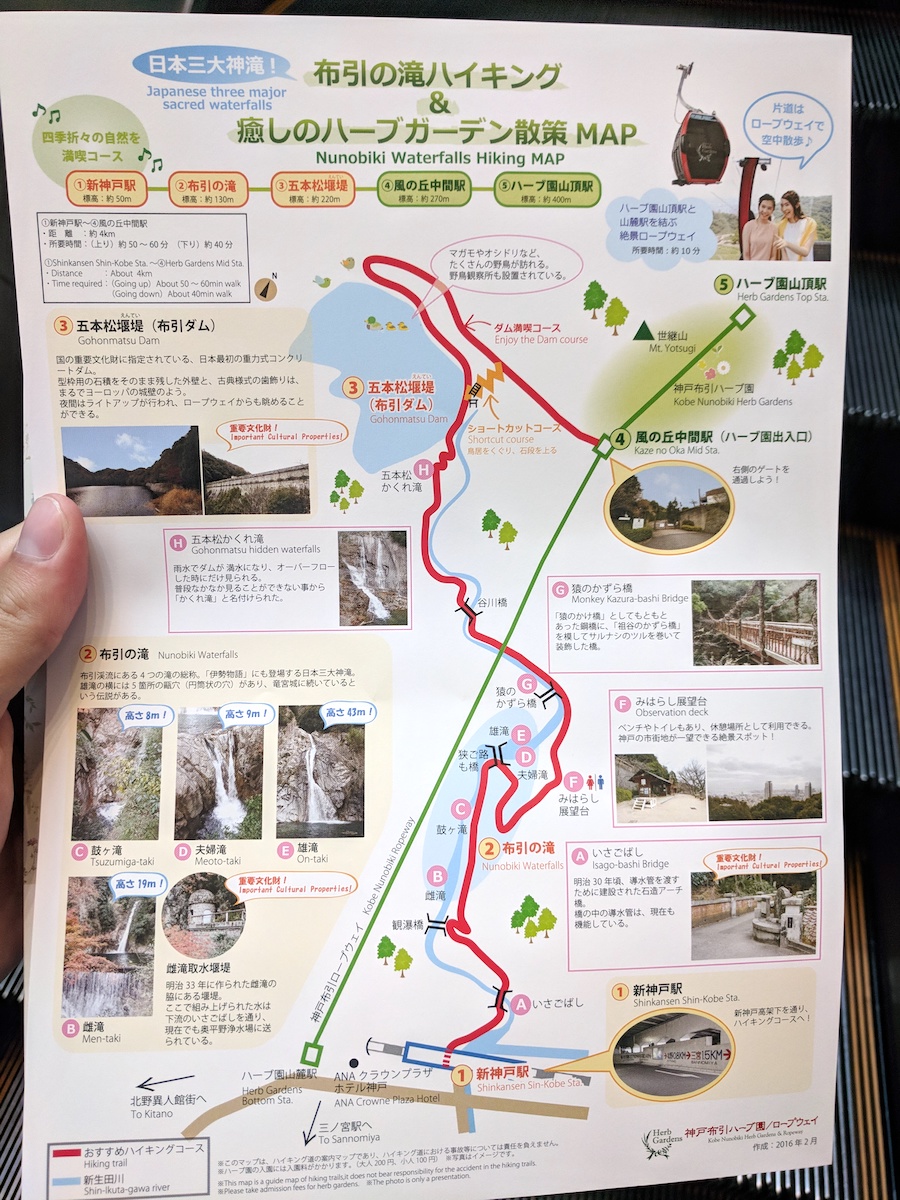
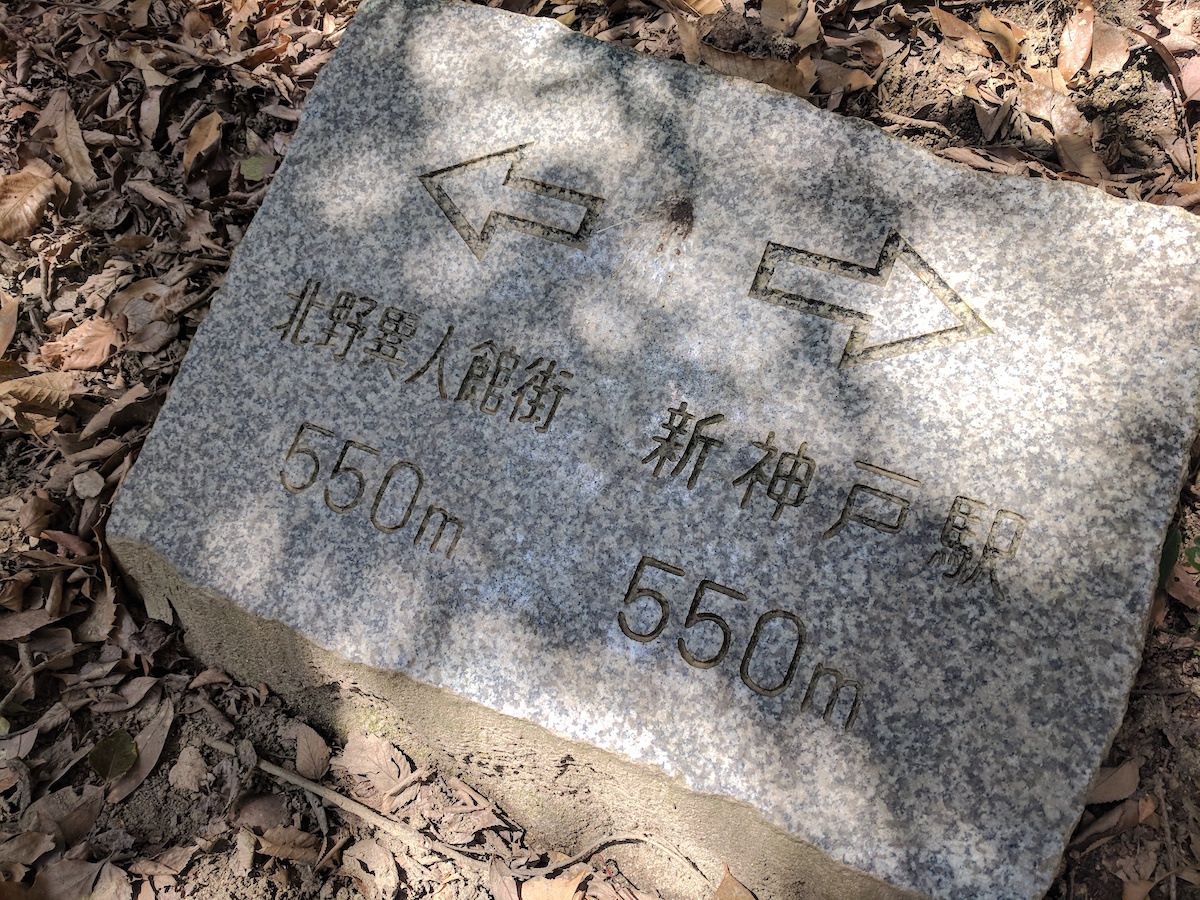
Left: The view from our first wrong trail. Middle: The map that would have helped us fail less. Right: Trailmarkers on our second wrong trail.
Luckily, the trail to the Herb Garden was a lot better. It had waterfalls, cherry blossoms, and more waterfalls. It was pretty steep at times, but we made it up to the Herb Gardens in exactly an hour. Since we walked up, rather than take the cable car, we were never asked to pay an entrance fee, either! The gardens themselves are quite steep as well, and we stopped for lunch on the terrace attached to their Greenhouse on the way up. While the basic food was fine, the real treat was the view, as well as the free hot herbal foot spa that helped breathe some life back into my tired feet. We did finally make it all the way to the top, though honestly the views from the lunch terrace were better. Getting down from the very top all the way back to the train station took only 35 minutes, though we just barely missed a train and by an uncharacteristic quirk of the schedule had to wait almost an hour for the next one back to Osaka.
Once again having tired ourselves out, we grabbed some take out dinner, ate at our Airbnb, and got ready to check out the next morning.
Day 7: While we could have taken any eligible train onward to Hiroshima, we had reserved seats on the 11:08am departure and wanted to make it onboard that one (which we did without a problem!). On the way, we stopped for me to make an attempt to buy baseball tickets.
Baseball is huge in Japan. The fans are really dedicated, and we’re told the atmosphere is more like a European soccer match than an American baseball game. That said, of course I wanted to go to a game while in Japan, but unfortunately didn’t check the schedule until after we had booked Airbnbs and our dates didn’t line up with any home games. But, I had missed that Tokyo had multiple teams, and it turns out the Yakult Swallows play in Tokyo and would be hosting the famed Yomiuri Giants, the most popular team in Tokyo. While they have an English online ticket portal, it only sells the most expensive tickets, so we had to resort to how the locals buy baseball tickets: from a copy machine at a convenience store!
Okay, okay, that’s only true at 7-11s. We stopped at a Sunkus (Circle K), where they have an ATM-like touchscreen for buying sports tickets and a whole lot else. The whole system is only available in Japanese, but I came prepared with the tickets I wanted written out in Japanese on my phone, got some help from the store clerk, and then ended up getting helped remotely by an attendant from that ticket company who spoke some English and was able to help me buy exactly what I wanted for when we’re in Tokyo!
For our visit to Japan, we budgeted more than almost anywhere else we’re going (and kept the overall time in Japan to two weeks, when we otherwise may have stretched it out a bit more). After so much time in Southeast Asia, prices have definitely been a bit of a shock, but it is ultimately pretty comparable to DC if you stay away from the 50 USD gourmet sushi boxes and dozens of Michelin-starred restaurants.
For our time in Osaka, we had budgeted as much as 90 USD a night for accommodations. We ended up spending 78 USD per night for our Airbnb in Osaka, which had a small kitchenette and everything we needed, despite being in total about the size of our bedroom back in DC.
We had also budgeted 20 USD per day per person for food and 15 USD per day per person for entertainment. Out of that planned 70 USD total, we ended up spending 61 USD per day on average, including almost 50 USD total on metro trips around Osaka and Kyoto. We budgeted separately for our two-week nationwide Japan Rail Pass, which end up costing about 30 USD per person per day (but are still way cheaper than buying bullet train tickets individually!).